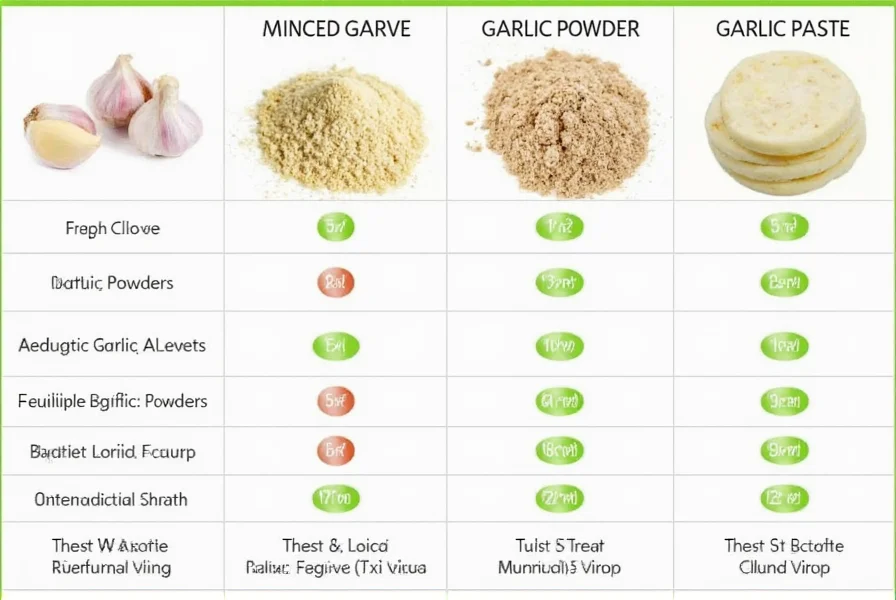Understanding garlic measurements is crucial for home cooks and professional chefs alike. When recipes call for specific quantities of garlic, knowing the exact conversion from whole cloves to minced form ensures your dishes achieve the perfect flavor balance without overpowering other ingredients.
Garlic Measurement Fundamentals
The standard conversion for garlic cloves to minced measurements depends primarily on clove size. While the 1:1/2 teaspoon ratio works for medium cloves, variations exist across different garlic types and growing conditions:
| Garlic Clove Size | Minced Measurement | Chopped Measurement |
|---|---|---|
| Small (1/2" long) | 1/4 teaspoon | 1/2 teaspoon |
| Medium (3/4" long) | 1/2 teaspoon | 1 teaspoon |
| Large (1"+ long) | 3/4-1 teaspoon | 1 1/2 teaspoons |

Factors Affecting Garlic Measurements
Several variables influence the precise conversion from whole cloves to minced garlic:
- Cultivar differences - Some garlic varieties naturally produce larger or smaller cloves
- Moisture content - Freshly harvested garlic contains more moisture than stored bulbs
- Preparation technique - How finely you mince affects volume (finer mince packs more densely)
- Age of bulb - Older garlic dries out, reducing volume when minced
Garlic Form Conversion Guide
Understanding different garlic forms helps when substituting ingredients. Here's how various garlic preparations relate to one another:
- 1 medium garlic clove = 1/2 teaspoon minced garlic
- 1 teaspoon minced garlic = 1 1/2 teaspoons chopped garlic
- 3 cloves fresh garlic = 1 teaspoon garlic powder
- 1/8 teaspoon garlic powder = 1 fresh clove (for strong garlic flavor)
- 1/2 teaspoon garlic paste = 1 medium clove

Practical Cooking Applications
When following recipes, consider these practical tips for accurate garlic measurement:
For most savory dishes, the standard garlic clove to teaspoon minced conversion works well. However, delicate sauces or subtle-flavored dishes may require more precise measurement. When a recipe specifies "1 clove," assume a medium-sized clove unless otherwise noted.
Professional chefs often recommend smashing garlic before mincing to release more flavor compounds. This technique doesn't change the volume measurement but does intensify the garlic flavor in your dish.
If you're working with pre-minced garlic from a jar, remember that commercially prepared minced garlic often contains preservatives that can slightly alter both volume and flavor intensity compared to freshly minced.
Storage and Freshness Considerations
Freshness dramatically impacts garlic's potency. A newly harvested clove delivers more intense flavor than one that's been stored for months. When substituting measurements in older recipes, you might need to adjust quantities based on your garlic's freshness.
Properly stored garlic (in a cool, dark place with good air circulation) maintains optimal flavor for 3-5 months. As garlic ages, its flavor compounds break down, potentially requiring slightly more volume to achieve the same flavor impact.
Common Measurement Mistakes to Avoid
Cooks frequently make these errors when measuring garlic:
- Using heaping teaspoons instead of level measurements
- Not accounting for clove size variations in recipes
- Substituting garlic powder without adjusting quantities properly
- Measuring minced garlic immediately after cutting (allow 10 minutes for flavor compounds to develop)
For the most accurate results in garlic measurement for cooking, use a proper measuring spoon and level off the minced garlic rather than packing it down.
Frequently Asked Questions
How much jarred minced garlic equals one fresh clove?
One teaspoon of jarred minced garlic typically equals one medium fresh garlic clove. However, jarred garlic often contains preservatives and may have a slightly milder flavor, so you might need to use 10-15% more for equivalent flavor intensity.
Can I substitute garlic powder for fresh minced garlic?
Yes, but use caution. The general conversion is 1/8 teaspoon garlic powder for 1 fresh clove. Garlic powder is more concentrated, so start with less and adjust to taste. Remember that powder lacks the fresh, pungent quality of raw garlic.
Why does my minced garlic measurement seem off?
Several factors affect garlic measurements: clove size variation, how finely you mince, moisture content, and whether you pack the spoon. For consistent results, use level measurements and consider your garlic's size relative to standard medium cloves.
How do I measure garlic without a teaspoon?
If you lack measuring spoons, use visual references: one medium minced clove should roughly fill the tip of your index finger from the first knuckle. Alternatively, remember that 1/4 teaspoon is about the size of a small pea, and 1/2 teaspoon equals two small peas.
Does roasting garlic change the measurement conversion?
Roasting concentrates garlic flavor while reducing volume. One roasted medium clove equals approximately 1/4 teaspoon of raw minced garlic in terms of flavor impact, though the physical volume decreases by about 30% during roasting.










 浙公网安备
33010002000092号
浙公网安备
33010002000092号 浙B2-20120091-4
浙B2-20120091-4